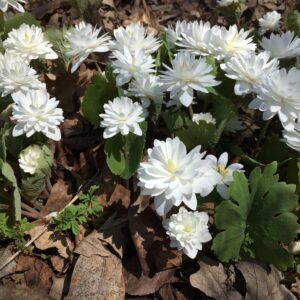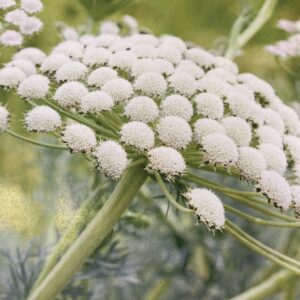"New" Heirloom Plants
Showing 49–56 of 62 results
-
Sanguinaria canadensis f. multiplex Double-flowered bloodroot Z 4-8
Snowballs of pure white open to dozens of petals atop unfolding, glaucous, grey-green mitten-shaped foliage in early spring. By late spring it recedes into the earth and goes dormant. Inside its roots are same red sap as in the single form. It is sterile and can only be propagated by division.
OUT OF STOCK
Ephemeral- Available for purchase in spring only
Snowballs of pure white open to dozens of petals atop unfolding, glaucous, grey-green mitten-shaped foliage in early spring. By late spring it recedes into the earth and goes dormant. Inside its roots are same red sap as in the single form. It is sterile and can only be propagated by division.
LIMITED QUANTITIES AVAILABLE, LIMIT OF 1 PER CUSTOMER PLEASE
Size: 6” x 12”
Care: part-shade to shade in moist well drained soil. Mark its location so you don’t forget in September and dig into it.
Native: mutation of native American single-form
Wildlife Value: deer resistant
Awards: Royal Horticultural Society named this one of the top plants of the last 200 years Award of Garden Merit; Great Plant Pick 2004Discovered by Guido von Webern growing in a clump of single Bloodroots in the 7 acre plot he recently purchased at the corner of North Main St and Turner Rd in Dayton OH in 1917.
-
Sanguisorba hakusanensis Korean burnet, Lilac squirrel Z 4 – 9
In mid to late summer bushy purplish-pink tails (like a Barbie doll squirrel tail) nod gracefully downward atop erect stems emerged from a clumping base that sprouts sage-colored, scalloped leaves.
OUT OF STOCK
In mid to late summer bushy purplish-pink tails (like a Barbie doll squirrel tail) nod gracefully downward atop erect stems emerged from a clumping base that sprouts sage-colored, scalloped leaves.
Size: 12-18”x12”
Care: sun to part shade in moist to moist well-drained soil
Native: Korea and JapanSanguisorba is Latin meaning to soak up blood, for the plant’s reputed ability to clot blood. Hakusanensis means coming from Haku, a mountain in Japan where this grows. Described in Botanical Magazine (Tokyo) in 1907.
-
Scrophularia macrantha syn. Scrophularia coccinea Redbirds in a Tree, Mimbres figwort Z 5-10
This sub-shrub blooms from early summer until frost with white-lipped cherry-red, tubular flowers that look like a flock of inch-long, baby birds with open mouths waiting for food, each topping short stems along the branches. The margins of its oval green leaves are toothed.
OUT OF STOCK – EMAIL FOR AVAILABILITY
This sub-shrub blooms from early summer until frost with white-lipped cherry-red, tubular flowers that look like a flock of inch-long, baby birds with open mouths waiting for food, each topping short stems along the branches. The margins of its oval green leaves are toothed.
Size: 2-4’ x 18”
Care: sun to part shade in well-drained to moist well-drained soil. Little to no fertilizer.
Native: Three mountain tops in southern New Mexico (high elevations make it hardy to cold regions)
Wildlife Value: Its nectar is one of the best feeders and attractors for hummingbirds. Pollen and nectar also attract butterflies and bees.
Awards: 2008 Plant Select WinnerFirst collected on the Mexican Boundary Expedition by Charles Wright (1811-1885) and John Bigelow (1804-1878), “at the base of a rocky ledge near the summit of a mountain . . .a truly handsome species.” Described by Asa Gray, Torrey, John ed. Report on the United States and Mexican boundary survey Vol. 2 p. 111 (1859)
-
Scutellaria altissima Somerset skullcap Z 4-10
In early summer masses of upright stems bearing bi-colored, bluish-purple and white, snapdragon-like flowers, the hood being bluish-purple and the lower lip white. Flowers grow on one side of the spike. This will re-bloom if you cut the flowers.
In early summer masses of upright stems bearing bi-colored, bluish-purple and white, snapdragon-like flowers, the hood being bluish-purple and the lower lip white. Flowers grow on one side of the spike. This will re-bloom if you cut the flowers.
Size: 24-36” x 18-24”
Care: sun to part shade in moist well-drained to well-drained soil
Native: central & eastern Europe
Wildlife Value: pollen and nectar attracts bees and butterflies1st described and named in 1700 by Joseph Pitton Tournefort, French botanist.
-
Scutellaria diffusa Turkish skullcap Z 5-10
Small snapdragonish violet flowers with white markings on two adjacent lower lips looking like an open book in summer along short stems. Flower clusters top tidy mounds of sage-colored, oval, hairy leaves.
OUT OF STOCK
Small snapdragonish violet flowers with white markings on two adjacent lower lips looking like an open book in summer along short stems. Flower clusters top tidy mounds of sage-colored, oval, hairy leaves.
Size: 4-6” x 12”
Care: sun in well-drained soil
Native: Turkey, Lebanon and Syria
Wildlife Value: deer resistantFirst published by Swiss botanist A.P.de Candolle in Prodr. 12: 421 (1848)
-
Seseli gummiferum Moon carrot Z 5-9 self-seeding biennial or short-lived perennial.
Five-inch diameter mound of many circles of pale pink to white flowers atop silvery, frilly, fern-like foliage flowering in mid-summer into early fall.
Five-inch diameter mound of many circles of pale pink to white flowers atop silvery, frilly, fern-like foliage flowering in mid-summer into early fall.
Size: 2-3’ x 12-18”
Care: Sun to part-shade in well-drained to moist well-drained soil
Native: Crimea, Turkey and South Aegean
Wildlife Value: Deer resistant. Butterfly magnet; host for caterpillar of Eastern swallowtail butterfly.Seseli is an ancient Greek name of an umbelliferous plant. This species first described by Linnaeus in 1735. In Re classified and renamed in 1830 in Prodromus systematis naturalis regni vegetabilis, sive, Enumeratio contracta ordinum generum specierumque plantarum huc usque cognitarium, juxta methodi naturalis, normas digesta.
-
Sesleria autumnalis Autumn Moor Grass Z 5-9
Fresh-green spring narrow blades of grass in summer add airy purplish flower spikes with silver-white stamens on this low mounding, arching grass. Blades have a striking yellow-green color that sometimes develops a soothing golden autumn tint. Spike-like silvery flowers rise above the leaves and mature into soft tan seed heads by autumn.
OUT OF STOCK
Fresh-green spring narrow blades of grass in summer add airy purplish flower spikes with silver-white stamens on this low mounding, arching grass. Blades have a striking yellow-green color that sometimes develops a soothing golden autumn tint. Spike-like silvery flowers rise above the leaves and mature into soft tan seed heads by autumn.
Size: 9-24” x 12-18”
Care: sun to part shade in moist well-drained to well-drained soil, drought tolerant
Native: SE Europe east to Caucusus
Wildlife Value: walnut, salt and deer tolerant
Awards: Royal Horticultural Society Award of Garden Merit. Gardens Illustrated “100 Must-Have Garden Plants,” 2013.Collected in Slovenian mountains near Idria, c. 1760 by and 1st described in Flora Carniolica by Giovanni Antonio Scopoli (1723-1788) physician, naturalist and author. Sesleria is named to honor Leonardo Selser, 18th century Italian botanist and physician, contemporary and likely friend of Scopoli
-
Succisa pratensis Devil’s bit scabiosus Z 5- 9
A tall, thin stem, unbranched until its upper quarter, then branching, each branch topped with its own flower head. Innumerable tiny flowers surround a global, lake-blue flower head, about the size of a ping-pong ball. Thread-like stamens poke out from the flowers all around the globe – blue too. Blooms for nearly three months mid-to-late summer into fall.
OUT OF STOCK
A tall, thin stem, unbranched until its upper quarter, then branching, each branch topped with its own flower head. Innumerable tiny flowers surround a global, lake-blue flower head, about the size of a ping-pong ball. Thread-like stamens poke out from the flowers all around the globe – blue too. Blooms for nearly three months mid-to-late summer into fall.
LIMITED QUANTITIES AVAILABLE, LIMIT OF 1 PER CUSTOMER PLEASE
Size: 2-4’ x 12”
Care: sun to part shade in moist to moist-well drained soil
Native: Europe to central Siberia, NW Africa
Wildlife Value: provides nectar and pollen to butterflies, moths, and beesHistorically this has made a dye, a tea, and seasoned food. It treated numerous medical conditions including scabies, eczema, fevers, wounds, syphilis and plague. Devil’s bit named for the legend that the Devil disapproved of the plant uses and attempted to destroy it by biting off its roots. First described by Swiss botanist Gaspard Bauhin in 1623, Pinax theatri botanici, with a different name. Linnaeus renamed it in Hortus Cliffortanus, 1737and then Möench renamed it to Succisa pratensis in 1794.



